Page 2 of 33 pages < 1 2 3 4 > Last »
Candlestick belonging to altar set
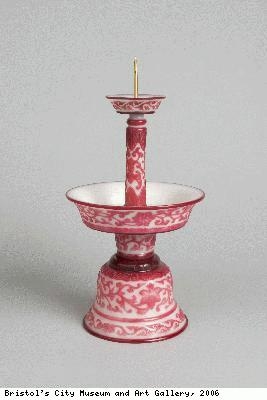
Description:
This candlestick, along with the incense burner (N4675) and candlestick (N4676), is part of a set for use on a Buddhist altar. They were made during the reign of the Qianlong emperor (pronounced chen-lung), probably in the palace glass workshops. The Qianlong emperor was a follower and strong supporter of Tibetan Buddhism, as were members of his court, and vessels like these would have been in high demand in the palace. Originally the set would have included a pair of flower vases.
Glass, carved overlay
Height: 24.0 cm, diameter: 12.4 cm
Four character mark of the Qianlong reign period (1736-1795)
Chinese Description:
香炉与烛台一对 中国,清乾隆朝 (1736-1795) 这组祭器除了陈列的三件器皿外,原应包括一对花瓶。它们大抵出于乾隆朝的宫廷造办处。 刻有「乾隆年制」四字 玻璃,套料浮雕Creator: Unknown
Date: Qianlong reign period (1736-1795)
Copyright: Bristol Museums, Galleries & Archives
Object ID:N4677
Candlestick belonging to altar set
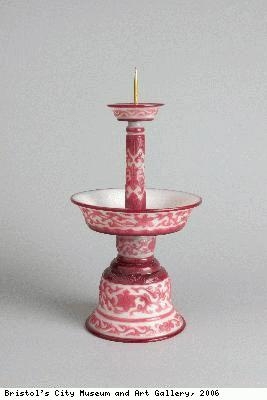
Description:
This candlestick, along with the incense burner (N4675) and candlestick (N4677), is part of a set for use on a Buddhist altar. They were made during the reign of the Qianlong emperor (pronounced chen-lung), probably in the palace glass workshops. The Qianlong emperor was a follower and strong supporter of Tibetan Buddhism, as were members of his court, and vessels like these would have been in high demand in the palace. Originally the set would have included a pair of flower vases.
Glass, carved overlay
Height: 24.5 cm, diameter: 12.3 cm
Four character mark of the Qianlong reign period (1736-1795)
Chinese Description:
香炉与烛台一对 中国,清乾隆朝 (1736-1795) 这组祭器除了陈列的三件器皿外,原应包括一对花瓶。它们大抵出于乾隆朝的宫廷造办处。 刻有「乾隆年制」四字 玻璃,套料浮雕Creator: Unknown
Date: Qianlong reign period (1736-1795)
Copyright: Bristol Museums, Galleries & Archives
Object ID:N4676
Burial accessory in the form of a pig
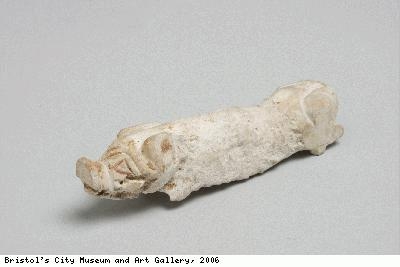
Description:
Archaeologists have found figures of pigs like this in burials. This example is made of glass but they were also made in jade. Figures of pigs are often found in pairs and are sometimes found in the hands of the dead.
The pig has been one of the most important animals in the Chinese diet since ancient times. People may have included figures shaped like pigs in burials to ensure the dead person had a constant supply of meat in the afterlife. In China pigs, with their fat bodies, are symbols of abundance as well as virility.
Glass (?), wheel-cut
Height: 2.7 cm, width: 2.5 cm, length: 11.5 cm
Chinese Description:
猪形明器 中国,汉代(公元前206-公元221 年) 考古学家在不少墓葬遗址发现相类的猪形明器。不同的是,那些塑像多为玉石所做的。这类猪形明器多成双成对的,又或由死者双手握着,或许祈求死者在阴间享有充足的肉食。 玻璃 (?), 轮刻Creator: Unknown
Date: Han dynasty (206 BC - 221 AD)
Copyright: Bristol Museums, Galleries & Archives
Object ID:N4811
Burial accessory
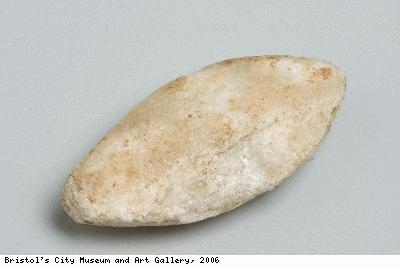
Description:
This small piece of glass may have been used in a burial. Often small pieces of jade were placed over the eyes, ears, mouth and nose of the deceased. This may be an alternative made in glass to cover the right eye of a dead person.
Glass (?), carved
Width: 1.9 cm, length: 3.9 cm, depth: 0.4 cm
Chinese Description:
玻璃明器 中国,年代不详 这件细小玻璃明器或用于墓葬。一般而言,细小的玉块会置放于死者的眼、耳、口及鼻,这件玻璃佩饰或为玉块的替代品,盖于死者的右眼。 玻璃 (?),碾琢Creator: Unknown
Date: Han dynasty (206 BC-221 AD) (?)
Copyright: Bristol Museums, Galleries & Archives
Object ID:N4806
Glass rod
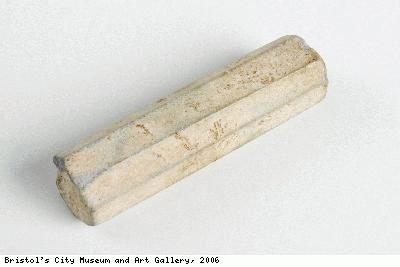
Description:
We are not sure about the original use of this object. It was probably found in a burial and may be a personal items, possibly part of a hair-pin.
Glass
Width: 1.1 cm, length: 4.0 cm, rod diameter: 0.9 cm
Chinese Description:
玻璃棒 中国,汉代(公元前206-公元220) 现时已无法查究这些玻璃棒的用途,或许它们属于随葬物品的组件之一,如发朁等私人的一部份。 玻璃Creator: Unknown
Date: Han dynasty (206BC-220AD)
Copyright: Bristol Museums, Galleries & Archives
Object ID:N4812C
Amulet, possibly Roman
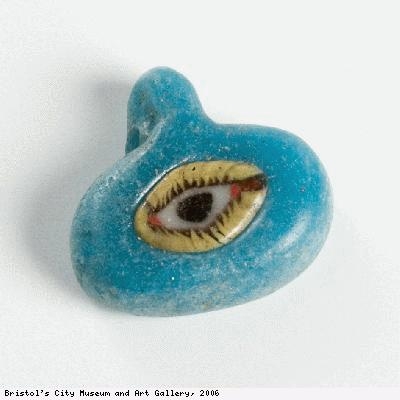
Description:
People in many countries from the Mediterranean to Central Asia have worn charms with eye designs to ward off evil.
This looks like some amulets in the British Museum which are thought to come from the Roman Empire and date to between 0 and 200 A.D. From ancient times, glass from the Middle East and the Mediterranean was taken to China along trade routes.
We do not know exactly where this amulet was found however archaeologists have found examples of Roman glass in Chinese tombs of the 1st century (0-100 AD).
Glass, inlaid
Height: 1.7 cm, width: 1.9 cm, depth: 0.5 cm
Chinese Description:
眼状护身符 出处与年代不详 古时中东及地中海地区的玻璃器物均自贸易路径流入中国,考古学家也曾在公元一世纪的中国墓葬遗址发现同类的罗马玻璃器物。不过,现时仍无法确定这护身符的出处。 玻璃,镶嵌Creator: Unknown
Date: 0-100 AD (?)
Copyright: Bristol Museums, Galleries & Archives
Object ID:00138 TEA
Pot
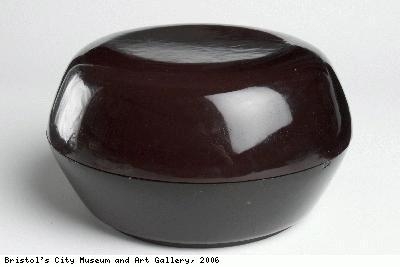
Description:
This red box has a mark of the Qianlong reign period (1736-1795) although it may be earlier or later in date. Experts and collectors saw the Qianlong period as the height of Chinese glassmaking so Qianlong marks were sometimes added to increase the value of glass objects.
Glass
Base height: 5.0 cm, base diameter: 17.0 cm, lid heigth: 4.8 cm, lid diameter: 15.9 cm, combined height: 9.7 cm
Wheel-cut four-character mark of Qianlong reign (1736-1795) in double square
Chinese Description:
玻璃盒 中国,清朝,约1700-1900 这玻璃盒刻有「乾隆年制」的帝号款识,尽管其出品年代可能更早或稍晚。专家和收藏家认为乾隆年间的出品乃是中国玻璃工艺的顶峰,所以其帝号款识或用以提高玻璃器物的价值。 玻璃 双方框内轮刻有「乾隆年制」四字Creator: Unknown
Date: Qianlong reign period (1736-1795)
Copyright: Bristol Museums, Galleries & Archives
Object ID:N4639
Saucer
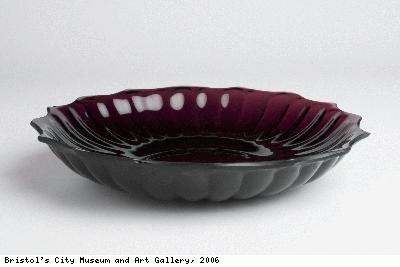
Description:
The fluted shape of this dish was made by blowing the glass into a mould. The rim of the dish was cut into shape with a wheel.
Glass, wheel-cut
Height: 3.5 cm, diameter: 18.4 cm
Chinese Description:
茶碟 中国,清朝,约1800-1900 这有凹槽的茶碟先将玻璃置于模具内吹制,再以研磨台等工具修饰边缘。 玻璃,轮刻Creator: Unknown
Date: 1800-1900, Qing dynasty
Copyright: Bristol Museums, Galleries & Archives
Object ID:N4609
One of a pair of water-containers
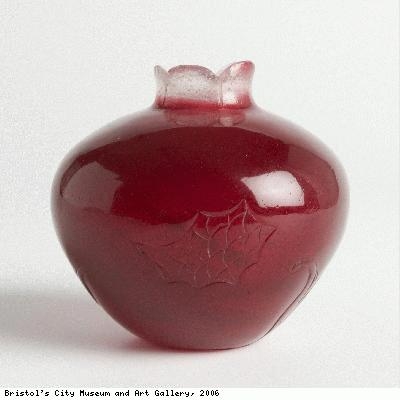
Description:
With their many red seeds, pomegranates are symbols of fertility in China and other countries. They are also considered to be one of the ‘three blessed fruit’, along with the peach and the ‘Buddha’s hand citron’. Together the three fruit symbolise great fertility, long life and happiness.
The imperial workshop records for 1773 in Beijing mention ‘a pair pomegranate-shaped jars, red overlay’ for the Emperor to give to the Dalai Lama, the spiritual leader of Tibetan Buddhism.
Glass, carved overlay
Height: 5.1 cm, diameter: 5.3 cm, neck diameter: 1.3 cm
One of a pair with N4659
Chinese Description:
石榴式水中丞 中国,清代,约1700-1800 在中国及许多国家,多籽的石榴一直是百子千孙的象征。民间更将桃子、香櫞与石榴并列为「三多」,是多寿、多福、多男子的吉祥图案。 玻璃,套料碾琢Creator: Unknown
Date: 1700-1800, Qing dynasty
Copyright: Bristol Museums, Galleries & Archives
Object ID:N4658
Planter
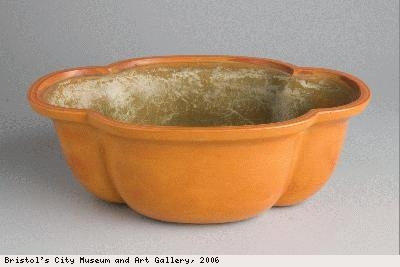
Description:
The orange glass used to make this lobed planter is streaked with crimson to make it resemble a mineral called realgar (arsenic sulphide). These planters were popular for growing bulbs, such as Chinese daffodils and narcissus, or miniature plants like bonsai.
Glass
Height: 7.6 cm, length: 21.5 cm, width: 15.3 cm
Four-character mark of Qianlong reign (1736-1795) in a double square
Chinese Description:
花口盆 中国,清乾隆朝(1736-1795) 这花口盆以红、橙双色玻璃相混成深红色的条纹,使它像一种称为雄黄(二硫化二砷)的矿物质。这些花盆通常用作种植球茎植物如中国水仙花和水仙属植物或盆景之类的微型植物。 玻璃 双方框内刻有「乾隆年制」四字Creator: Unknown
Date: Qianlong reign period (1736-1795)
Copyright: Bristol Museums, Galleries & Archives
Object ID:N4739

